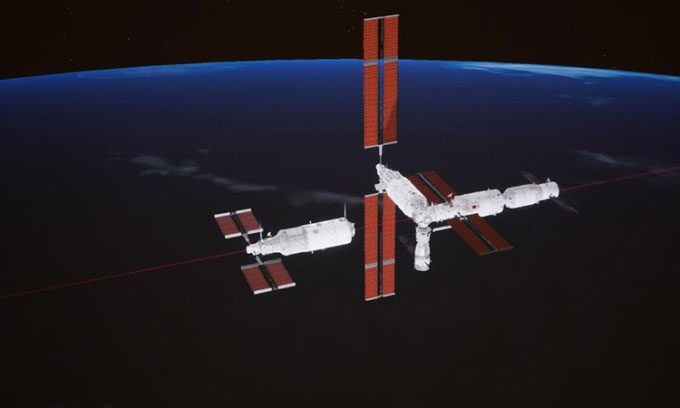The Dreaming Heaven laboratory module, the final main component of China’s space station, successfully docked with the Harmony module on the morning of November 1.
Images of the docking between the Dreaming Heaven module and Harmony. (Video: CCTV)
The Dreaming Heaven module, nearly 18 meters long and weighing 23 tons, was launched by the Long March 5B rocket from the Wenchang Satellite Launch Center on Hainan Island, China, at 3:37 PM Beijing time on October 31. It successfully reached its “orbital rendezvous point” after almost 13 hours of flight, according to the China Manned Space Agency (CMSA).
Images sent back from the Tiangong space station show that the Dreaming Heaven module successfully docked with the forward port of the central Harmony module at 4:27 AM on November 1. According to the plan, the Dreaming Heaven module will be repositioned in the near future to form a T-shaped structure with the Harmony and Wentian modules for the Tiangong station.
China took less than two years to assemble its first long-term space station. This orbital complex consists of three main components: the core Harmony module (launched in April 2021), the Wentian laboratory module (launched in July 2022), and finally, the Dreaming Heaven module. Compared to Wentian, the newly launched laboratory module is equipped with more research facilities, despite being the same size.

Simulation of the Dreaming Heaven module docking at the Tiangong space station. (Photo: Xinhua)
The Dreaming Heaven module carries 8 scientific experiment cabinets and provides 37 additional installation options, allowing for a range of physical experiments both inside and outside the cabin in a microgravity environment.
Onboard is the world’s first space atomic clock system, which includes hydrogen clocks, rubidium clocks, and optical clocks. This is also the most accurate orbital timing system in the world, according to Xinhua.
“This clock system will support basic physics research such as measuring gravitational redshift and verifying the constant speed of light. It can also be used to synchronize time for important scientific facilities like large particle accelerators and arrays of radio telescopes, thereby improving their performance,” emphasized designer Zhang Shougang, Director of the National Time Service Center at the Chinese Academy of Sciences.
Among the payloads of the Dreaming Heaven module is a tool capable of producing ultra-cold quantum gases near absolute zero, a device that can capture changes in matter at high temperatures using X-rays, and an advanced laboratory for fluid physics in space.
These platforms will create conditions unattainable on Earth, serving as a “nursery” for new technologies and materials such as alloy metals, crystals, and semiconductors.
China plans to launch another cargo ship to the Tiangong station in November, and to facilitate the transportation of larger cargo, the Dreaming Heaven module’s airlock is equipped with two square hatches, one inside and one outside.
Among these, the outer hatch is electrically operated, marking the first of its kind used in the history of global space stations. Bai Hemin, a designer of the space station system at the Shanghai Aerospace Technology Institute (SAST), stated that this automatic door will reduce the labor required from astronauts and increase efficiency when transporting goods out of the cabin.
With the larger hatch, the Dreaming Heaven module even has the capability to launch miniaturized satellites into space. “Astronauts can install small satellites on a payload transfer device, reduce the pressure in the pressurized cabin, and then push them out of the cabin,” added Meng Yao, a designer of the Dreaming Heaven module.
The Tiangong station and the International Space Station (ISS) are the two operational space stations in low Earth orbit. While the ISS is likely to deorbit in the early 2030s, the Tiangong station can expand from 3 to 6 modules, according to Chinese authorities.
It is expected that the Tiangong station will host over 1,000 scientific experiments throughout its operational period, including an international project between CMSA and the United Nations Office for Outer Space Affairs. In November, China plans to launch Tianzhou 5 – the fourth cargo mission to the Tiangong station to supply materials for the upcoming crewed Shenzhou 15 mission.


















































